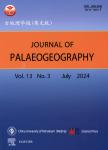Substrate control in track registration and preservation:insights across the Triassic—Jurassic boundary in southern Africa
作者机构:Department of Geological SciencesUniversity of Cape TownCape TownSouth Africa
出 版 物:《Journal of Palaeogeography》 (古地理学报(英文版))
年 卷 期:2024年第13卷第2期
页 面:351-371页
核心收录:
学科分类:070903[理学-古生物学与地层学(含:古人类学)] 0709[理学-地质学] 07[理学] 0708[理学-地球物理学]
基 金:supported from research grants obtained by MA(as PI)from the UCT Research Development Grant(2021) by EMB(as PI)from the Competitive Programme for Rated Researchers(GU93544,113394,98906) the African Origins Platform(GU 93544,98825)and GENUS(DSI-NRF Centre of Excellence in Palaeosciences grants 2015—2022),which are various programmes of the National Research Foundation(NRF)of South Africa Postgraduate funding was received by LM from the UCT General Award(2022),Palaeontological Scientific Trust(PAST),Johannesburg,South Africa and Genus(DSI-NRF Centre of Excellence in Palaeosciences)。
主 题:Dinosaur tracks Footprint anatomical fidelity Micro-sedimentary features Substrate conditions Track registration Palaeoenvironmental context
摘 要:Tracks registration is influenced by the dynamic interplay between the pedal anatomy of the trackmaker,its behaviour,and the substrate conditions it interacts with.Differences in substrate conditions,especially those linked to grain size and moisture content,often result in the most dramatic variations in track morphology.In the upper Stormberg Group,main Karoo Basin of southern Africa,diverse trace fossils,primarily comprising Late Triassic—Early Jurassic dinosaur tracks,are preserved.Numerous studies have extensively documented individual ichnosites,investigating variations between sites over time,with recent studies suggesting that track abundance and anatomical fidelity increase up-stratigraphy.Despite the well-established link between substrate and track morphology,past studies have not specifically focused on substrate conditions,often emphasizing macro-sedimentary features instead.Here,we examine the micro-sedimentary features of track-bearing units in the upper Stormberg Group using petrographic techniques to better understand the palaeosubstrate and its effect on fossil track registration and preservation.The analysis revealed that very fine-grained sandstones and substrates modified by microbial activity tend to preserve tracks with greater abundance and/or higher anatomical fidelity.Furthermore,the prevalence of very fine-grained and microbially modified strata,and their associated track trends increases in younger stratigraphic units.Across the Triassic—Jurassic boundary in southern Africa,a boom in dinosaur track abundances is observed and credited to the proliferation of dinosaur populations during the Early Jurassic.Our findings,however,suggest that the observed local increase in track abundance(and anatomical fidelity)up-stratigraphy may be linked to substrate composition differences,which were ultimately controlled by large-scale changes in the palaeoenvironment from high-energy meandering fluvial to lower-energy aeolian-lacustrine settings in the Late Triassic and Early Jurassic,respectively.These findings have implications for global macroevolutionary patterns,palaeo-geographical reconstructions,and biostratigraphic correlations in the early Mesozoic.



